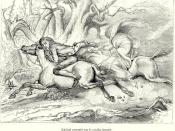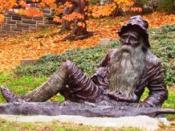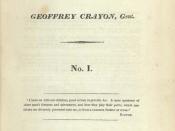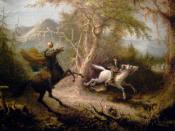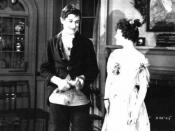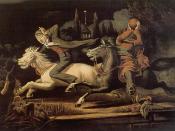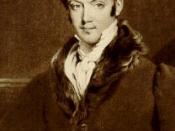A Clash between a Pre-Revolutionary and Post-Revolutionary World Washington Irving grew up during a period of change and turmoil in the world. He was born the year that England officially recognized the United States as an independent country. His unprecedented writing style was a new experience for American readers. Even though his works are known as lighthearted short stories, they also express strong views on controversial subjects in America at that time. Irving shows a dislike for the changing lifestyle in America. The United States was growing in many aspects, such as urbanization, which is a product of mass immigration. In his life, Irving watched America, a quiet, agricultural country turn into a loud, industrialized world power. He was a witness to the massive amount of immigrants coming to the United States. Irving's short stories "Rip Van Winkle" and "The Legend of Sleepy Hollow", from The Sketch Book of Geoffrey Crayon, show his animosity towards immigrants through his fictional communities' abuse of the foreigner and by depicting the negative changes in America after the Revolutionary War.
Irving first shows his disdain towards foreigners in "Rip Van Winkle". This is a simple tale of a friendly, well liked man, Rip, who leaves his small, Dutch village for a walk in the Catskill Mountains. Rip wakes up from a sleep and walks back to town, unaware that he has just fallen asleep for twenty years. Rip has missed the entire Revolutionary War and is unconscious to the many changes to America. Rip is described as "a simple good natured man; he was moreover a kind neighbor" (Irving, 27). However, upon Rip's return to town, he is not greeted by customary friendliness. The first difference Rip notices is by the dogs of the neighborhood. In the past, Rip was accustomed to kids at his heels, following his every move and the fact that "not a dog would bark at him throughout the neighborhood" (Irving, 27). Instead, he is welcomed by the opposite: barking dogs and people laughing at his beard. Rip observes the people around him and comments, "Strange children"æ.strange names"æ.strange faces"æ.everything was strange" (Irving, 34). Rip does not realize that he is the only strange element to the town because he is an outsider, an immigrant. Rip is now a foreigner to the village he once called home. This is because Rip has slept through a wave of immigration that has passed through his town. All it took was twenty years for Rip's town to be completely transformed. The population of the village is now so large and diverse that an original inhabitant is an outcast. Irving uses a popular village character as the eventual outsider to show the significant effect that post revolutionary colonization had on America.
Rip is the recipient of more criticism when he is asked the question of "Whether he was a Federal or Democrat?" (Irving, 36). Rip, thinking that United States is still under control of England, answers "I am a loyal subject to the king, God bless him" (Irving, 36). Upon hearing this answer, the townspeople verbally abuse and threaten Rip, labeling him as a Tory and a spy. The victory in the Revolutionary War and independence gave Americans a strong sense of nationalism, which is why the community is outraged when Rip pledges to the enemy. They feel Rip is devoted to England, and they see him as an unwanted outsider of the village. After Rip explains his story to the village citizens, his life does not go back to the way it once was. Rip Van Winkle is no longer seen as a friendly, good natured neighbor. Instead, the community views him as a man with an unstable personality with an unfathomable story that is impossible to believe. Rip is now a man with a different lifestyle and customs, as is any immigrant who enters a place to which he is unaccustomed and unwelcome.
After his return to town, Rip not only has trouble adapting to people, but he also has hardships adapting to post revolutionary life in America. Irving shows scorn towards foreigners in his descriptions of the town and its inhabitants. Irving begins his narrative with vivid imagery while describing Rip's hometown. Irving introduces the reader to "a village, whose shingle roofs gleam among the trees, just where the blue tints of the upland melt away into the fresh green of the nearer landscape" (Irving, 26). Irving is using magical realism in his writing to signify a very unique and tightly knit community that Rip is an integral part of. However, when Rip returns home after his sleep, it is no longer a "village of great antiquity, having been founded by some of the Dutch colonists in the early times of the province" (Irving, 26). Irving describes this new town as "altered- it was larger and more populous" (Irving, 34). Rip's village is a metaphor for America, before and after the War. The reason why the village is "larger and more populous" is because of the tremendous number of immigrants flocking to the United States.
Irving changes his literary style in terms of the detail seen in the descriptions of the village to convey the thought that this magical community has been contaminated by others. The inhabitants of the town are no longer Dutch. Irving comments, "Their dress, too, was of a different fashion from that to which he was accustomed" (Irving, 34). The people of the town have different cultural and racial makeup; the traditional Dutch attire is not seen as typical, daily dress. This quaint, Dutch community with strong values and customs has been somewhat diluted by outsiders moving in. The settlement of immigrants in America during this time period created a loss of cultural tradition and identification in this Dutch community, as well as in other cultural communities in the United States.
Another culturally strong community is disrupted in the short "The Legend of Sleepy Hollow". But, unlike Rip's town, Sleepy Hollow is still culturally distinct, and they are disturbed by only one outsider. In this story, a foreigner enters another tightly-knit Dutch community in which "population, manners and customs remain fixed" (Irving, 295). The foreigner, Ichabod Crane, is described by Irving as "tall, but exceedingly lank"æ.long arms and legs"æ.his head was small, and flat at top, with huge ears, large green glassy eyes, and a long snipe nose" (Irving, 295). Ichabod Crane is an outsider in many aspects; his physical features are strange, highlighting Ichabod's grotesque appearance. In direct contrast to Ichabod is his nemesis, Brom Bones, who is an original inhabitant of Sleepy Hollow. Irving describes Brom as "short curls, black hair, and a bluff but not unpleasant countenance, having a mingled air of fun and arrogance" (Irving, 303). Irving contrasts the protagonist and antagonist in describing their appearances to further the difference between the immigrant and the Dutch community he invades.
In addition to appearance, Icabod is also an outsider in terms of personality. Many of the children of Sleepy Hollow dislike Mr. Crane because he is an elementary schoolteacher, a man responsible for depriving the children of their fun because he is the authority of the schoolhouse. Ichabod also is the recipient of castigation from Brom Bones and his gang of thugs. When Brom finds out that Ichabod is in pursuit of his love, Katrina Van Tassel, "Ichabod became the object of whimsical persecution to Bones and his gang of rough riders" (Irving, 305). The outcast, Ichabod, is so different from everyone else that he serves as a scapegoat for problems within Sleepy Hollow, while known prankster, Brom Bones is "looked upon with a mixture of awe, admiration and good will" (Irving, 303). Ichabod not only looks completely different from everyone else, but he also does not have one companion. Ichabod is truly on the outside of this culturally strong Dutch community. Irving makes distinct differences between Crane and the members of the Dutch community to show that the foreigner is not welcome in Sleepy Hollow.
Through the community's harassment of the foreigner we see the metamorphosis of American society after the Revolutionary War. Unlike "Rip Van Winkle", the foreigner to the town, Ichabod, represents post-Revolutionary life in America, while the community of Sleepy Hollow symbolizes a traditional Dutch community before the Revolutionary War. Even though the War has already passed, Irving makes it clear that Sleepy Hollow was not affected by the War with his quotation, "such little retired Dutch valleys, found here and there embosomed in the great state of New York, that population, manners, and customs remain fixed; while the great torrent of migration and improvement, which is making such incessant changes in other parts of this restless country, sweeps by them unobserved" (Irving, 295). Sleepy Hollow is a town that is hidden away from the changes of the country, which is why Ichabod stands out in the town. Although he is a native of Connecticut, and not a true immigrant to the United States, Ichabod Crane is an outsider to the town of Sleepy Hollow; he has different physical features, customs and interests. One of his hobbies is witchcraft, which he would read to the women of Sleepy Hollow "the direful omens and portentous sights and sounds in the air, which prevailed in the earlier times of Connecticut" (Irving, 299). Irving hints at a major change in lifestyle for America because he explains how witchcraft was once a popular interest in Connecticut. Irving refers to "earlier times" as pre-revolutionary life in America, where ancient customs and traditions were preserved and practiced. A perfect example of a "pre-revolutionary" town is Sleepy Hollow. A reason why Ichabod is an outsider to Sleepy Hollow is because he represents a post-revolutionary idealism. The Dutch community has such a backlash against Ichabod because Irving is expressing his displeasure for the new, post-revolutionary lifestyle in America. The Revolutionary War opened the door for the arrival of immigrants who brought their own traditions to blend into the "Melting Pot" which is America today. Irving shows a disdain towards foreigners because the arrival of these immigrants also debilitated the cultural purity of ethnic communities in the United States. Ichabod Crane represents one of these communities "tarnished" after the War.
Washington Irving shows a clear dislike for immigrants by disguising his views in the short stories "Rip Van Winkle" and "The Legend of Sleepy Hollow".
Although these stories were written for the enjoyment of the reader, Irving has a common theme of abuse of the outcast, from the community members, and by the negative changes brought by the conclusion of the Revolutionary War. Irving demonstrates his love for the once rural, unscathed area of the Hudson River in upstate New York. "In these stories, poems in prose, the author utilized, as the pathway and inspiration for his imagination, the great river of which he was so fond" (Trent, et. al.) Irving used magical realism to make the Hudson River area an enchanted place where it is possible to sleep for twenty years, or be haunted by the "Headless Horseman". These magical elements obstruct Irving's pessimism towards immigrants because readers were not accustomed to fictional short stories. Washington Irving, through the voice of Rip Van Winkle, represents a Pre-Revolutionary train of thought and lifestyle in a Post-Revolutionary country. Irving, through Ichabod Crane, shows the invasion of a foreigner into a pre-revolutionary society of Sleepy Hollow. Although the two protagonists, Rip and Ichabod, are completely different, they are both criticized and treated in a harsh and unfair manner because they represent a culture unlike the one they have entered. Irving shows a negative view of immigrants through a clash between a pre and post-revolutionary life. Clearly, Irving prefers life before the Revolutionary War; his writings disparage the foreigner because they have disrupted the purity of identifiable cultures in America.
Works Cited Irving, Washington. The Legend of Sleepy Hollow and other Stories or, The Sketch Book of Geoffrey Crayon, Gent. New York, NY: Random House, 2001.
Putnam, George H. The Cambridge History of English and American Literature: An Encyclopedia in Eighteen Volumes. 25 July, 2001. http://www.bartleby.com Retrieved 28 September, 2001.
